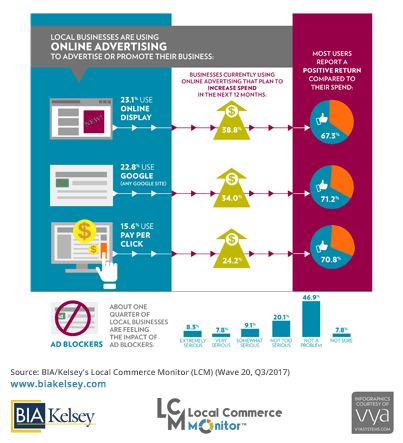 According to an IAB report, 26 percent of desktop users and 15 percent of mobile consumers use blockers to remove ads from publishers’ websites. eMarketer expects three in 10 internet users will be using blockers by the end of 2018. IAB also noted that twenty percent of consumers were convinced to stop using them because a blocker wiped out a publisher’s content, for instance, or messages asked them to turn ad blocking off.
According to an IAB report, 26 percent of desktop users and 15 percent of mobile consumers use blockers to remove ads from publishers’ websites. eMarketer expects three in 10 internet users will be using blockers by the end of 2018. IAB also noted that twenty percent of consumers were convinced to stop using them because a blocker wiped out a publisher’s content, for instance, or messages asked them to turn ad blocking off.
Ad blockers impact a publisher’s revenue and site traffic and in turn a small business’s ability to get their product and services in front of consumers . Small businesses use targeted online products as part of their marketing strategies and will continue to invest in these channels due to the strong ROI they see and the targeting capabilities. In fact only a quarter of small businesses are feeling the impact of ad blockers on their advertising according to our Local Commerce Monitor ™(LCM) survey of small businesses.
Publishers should make sure small businesses ads are genuine, targeting the needs and behaviors of the consumers they are reaching instead of a cookie cutter. Publishers should focus on the quality of the original content where the ads are placed and assist small business clients in being creative in their ads and messaging. Pingzic recent put out a comprehensive list of the best ad blockers and how they work .
Two reports with findings from the Plus Spender SMB portion of the LCM survey are available for purchase: the condensed report, Plus Spenders SMBs TRENDS – LCM Wave 20 and the complete survey and findings, Plus Spenders SMBs REPORT – LCM Wave 20.
